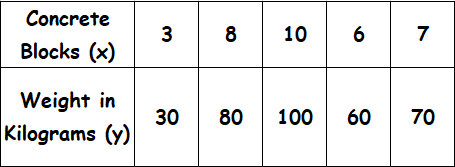CONSTANT OF PROPORTIONALITY FROM A TABLE WORKSHEET
Subscribe to our ▶️ YouTube channel 🔴 for the latest videos, updates, and tips.
Problem 1 :
Examine the given table and determine if the relationship is proportional. If yes, determine the constant of proportionality.

Problem 2 :
Examine the given table and determine if the relationship is proportional. If yes, determine the constant of proportionality. And also, explain what does the constant of proportionality mean?

Problem 3 :
Examine the given table and determine if the relationship is proportional. If yes, determine the constant of proportionality. And also, explain what does the constant of proportionality mean?

Problem 4 :
Examine the given table and determine if the relationship is proportional. If yes, determine the constant of proportionality. And also, explain what does the constant of proportionality mean?

Problem 5 :
Examine the given table and determine if the relationship is proportional. If yes, determine the constant of proportionality. And also, explain what does the constant of proportionality mean?

Problem 6 :
Examine the given table and determine if the relationship is proportional. If yes, determine the constant of proportionality. And also, explain what does the constant of proportionality mean?

Problem 7 :
Examine the given table and determine if the relationship is proportional. If yes, determine the constant of proportionality. And also, explain what does the constant of proportionality mean?


1. Answer :

Find the ratio of x and y for all the given values.
3/30 = 1/10
8/80 = 10
10/100 = 1/10
9/60 = 1/10
7/70 = 1/10
When we take ratio of x and y for all the given values, we get equal value for all the ratios.
Therefore, the relationship given in the table is proportional.
When we look at the above table when x gets increased, y also gets increased, so it is direct proportion.
Then, we have
y = kx
Substitute 3 for x and 30 for y.
30 = k(3)
10 = k
So, the constant of proportionality is 10.
That is, every concrete block weighs 10 kilograms.
2. Answer :

Find the ratio of x and y for all the given values.
5/15 = 1/3
10/30 = 1/3
6/18 = 1/3
9/27 = 1/3
2/6 = 1/3
When we take ratio of x and y for all the given values, we get equal value for all the ratios.
Therefore, the relationship given in the table is proportional.
When we look at the above table when x gets increased, y also gets increased, so it is direct proportion.
Then, we have
y = kx
Substitute 5 for x and 15 for y.
15 = k(5)
3 = k
So, the constant of proportionality is 3.
That is, for every can of paint, you could paint 3 bird houses.
3. Answer :

Find the ratio of x and y for all the given values.
9/342 = 1/38
7/266 = 1/38
6/228 = 1/38
8/304 = 1/38
3/114 = 1/38
When we take ratio of x and y for all the given values, we get equal value for all the ratios.
Therefore, the relationship given in the table is proportional.
When we look at the above table when x gets increased, y also gets increased, so it is direct proportion.
Then, we have
y = kx
Substitute 9 for x and 342 for y.
342 = k(9)
38 = k
So, the constant of proportionality is 38.
That is, for every vote for Faye there were 38 votes for Victor.
4. Answer :

Find the ratio of x and y for all the given values.
6/1212 = 1/202
4/808 = 1/202
10/2020 = 1/202
3/606 = 1/202
8/1616 = 1/202
When we take ratio of x and y for all the given values, we get equal value for all the ratios.
Therefore, the relationship given in the table is proportional.
When we look at the above table when x gets increased, y also gets increased, so it is direct proportion.
Then, we have
y = kx
Substitute 6 for x and 1212 for y.
1212 = k(6)
202 = k
So, the constant of proportionality is 202.
That is, every chocolate bar has 202 calories.
5. Answer :

Find the ratio of x and y for all the given values.
7/14 = 1/2
8/16 = 1/2
6/12 = 1/2
10/20 = 1/2
2/4 = 1/2
When we take ratio of x and y for all the given values, we get equal value for all the ratios.
Therefore, the relationship given in the table is proportional.
When we look at the above table when x gets increased, y also gets increased, so it is direct proportion.
Then, we have
y = kx
Substitute 6 for x and 1212 for y.
1212 = k(6)
202 = k
So, the constant of proportionality is 202.
For each piece of chicken it costs 2 dollars.
6. Answer :

Find the ratio of x and y for all the given values.
16/8 = 2
24/12 = 2
12/6 = 2
20/10 = 2
4/2 = 2
When we take ratio of x and y for all the given values, we get equal value for all the ratios.
Therefore, the relationship given in the table is proportional.
When we look at the above table when x gets increased, y gets decreased, so it is inverse proportion.
Then, we have
y = k/x
Substitute 16 for x and 8 for y.
8 = k(16)
1/2 = k
So, the constant of proportionality is 1/2.
7. Answer :

Find the ratio of x and y for all the given values.
2/32 = 1/16
5/80 = 1/16
9/144 = 1/16
7/144 = 1/16
10/160 = 1/16
When we take ratio of x and y for all the given values, we get equal value for all the ratios.
Therefore, the relationship given in the table is proportional.
When we look at the above table when x gets increased, y gets decreased, so it is inverse proportion.
Then, we have
y = kx
Substitute 2 for x and 32 for y.
32 = k(2)
16 = k
So, the constant of proportionality is 16.
That is, for every box of candy you get 16 pieces.
Subscribe to our ▶️ YouTube channel 🔴 for the latest videos, updates, and tips.
Kindly mail your feedback to v4formath@gmail.com
We always appreciate your feedback.
About Us | Contact Us | Privacy Policy
©All rights reserved. onlinemath4all.com

Recent Articles
-
US Common Core K-12 Curricum Algebra Solving Simple Equations
Jan 07, 26 01:53 PM
US Common Core K-12 Curricum Algebra Solving Simple Equations -
10 Hard SAT Math Questions (Part - 4)
Jan 05, 26 06:56 PM
10 Hard SAT Math Questions (Part - 4) -
10 Hard SAT Math Questions (Part - 3)
Jan 05, 26 06:34 PM
10 Hard SAT Math Questions (Part - 3)

